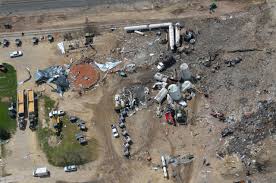Concerns Raised Over OSHA Fines for West Fertilizer Company
- Oct 27, 2013
 On April 17, 2013 a massive explosion rocked the otherwise quiet community of West, Texas. The town was Home to West Fertilizer Company, a distribution center where fertilizer and fertilizer components were stored on-site in large quantities. Among the chemicals at West Fertilizer was highly volatile Ammonium Nitrate - a major contributor to the ferocity of the explosion that occurred as the direct result of an out of control fire at the facility.
On April 17, 2013 a massive explosion rocked the otherwise quiet community of West, Texas. The town was Home to West Fertilizer Company, a distribution center where fertilizer and fertilizer components were stored on-site in large quantities. Among the chemicals at West Fertilizer was highly volatile Ammonium Nitrate - a major contributor to the ferocity of the explosion that occurred as the direct result of an out of control fire at the facility.The intensity and shockwave of the blast killed 15, injured 300 and damaged at least 150 surrounding buildings, completely destroying many structures that were in close proximity, several of which were apartment buildings and homes.
Nearly 6 months later, many are raising valid questions in regards to workplace safety, as well as the safety of residents who are located near similar facilities. Time and time again, many want to know why a facility with such destructive potential in the circumstance of an accident could be permitted to operate so closely to residential areas. Furthermore, many residents and relatives of those injured or killed in the blast are downright angry with one thing in particular - OSHA.
Two weeks ago, OSHA proposed $118,300 in fines towards the owner of the West Fertilizer Company, citing 24 serious safety violations. As none of the violations were found as willful, the maximum penalty for each instance is $7,000. Had the safety violations found by OSHA to be willful, the company would face a maximum penalty of $70,000 per violation.
While the OSHA procedure for determining fines seems to be quite cut and dry, the question being raised by many is with 24 'serious violations' discovered, how is it possible that none of those were willful? Especially considering that OSHA determined the violations to be a direct cause of the explosion? For a scenario where there was a large loss of life, hundreds of injuries and unprecedented property damage, how could these safety violations be seen as non-willful?
When safety standards are set for a facility to operate by, that facility is expected to live up to those standards as an assurance of best practices to prevent and/or reduce accidents such as the explosion at West Fertilizer Company. Therefor, it's hard for many to swallow the idea that 24 serious offenses (violations of safety code) could be issued without a single violation being considered willful. And it makes sense.
Let's consider, for example, if a person were driving to work in a busy area and a pedestrian jumped out in front of their vehicle. The driver may have not had a chance to stop in time, and since the situation was out of the driver's control they couldn't possibly be at fault. But let's just say that the driver had bad brakes on the car… They knew the brakes were bad, failed to fix them and willingly continued to drive with a compromised vehicle. Could that driver had stopped in time if the brakes were operating safely? Even more so, lets just assume that the road conditions were wet, their wiper blades were worn and not functioning correctly, plus their tires completely lacked tread necessary to stop quickly. Is the accident still out of the driver's control, or could the fact that the driver neglected to have repairs made be a legitimate factor that contributed to the fatality of the pedestrian?
At some point, a line has to be drawn. The idea that 24 serious safety offenses were identified which were directly responsible for a deadly explosion, yet not 'willful', is a very hard story to swallow for the families of the victims and the residents located nearby who lost their homes. At which point do these violations reach the level where they're considered willful neglect?
Recently, OSHA fined a general contractor and sub-contractors $280,000 for violations at a job site in new Hampshire where a power plant was being constructed, yet there were no injuries or fatalities. In fact, the site was only inspected due to complaints filed by workers.
While it's clear that OSHA's system for fines is not relevant to the number of injuries or deaths and is instead determined by the number and character of the violations themselves, you have to wonder if a numerous safety violations resulting in such destruction should ever be able to be labeled as non-willful. In this case, many are finding it as a slap in the face and a complete lack of justice.

